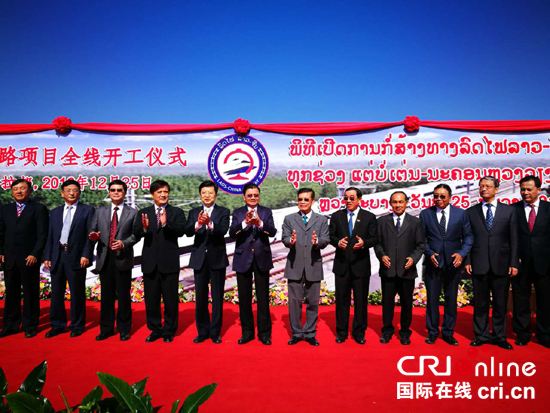

 |
| A ceremony marking the beginning of construction of the railway is held on Dec. 25, 2016. |
VIENTIANE, March 28 (Xinhua) -- Over 200 million liters of fuel is expected to be consumed in the construction of the railway linking Vientiane with the Chinese border over the next five years, local daily Vientiane Times quoted a Lao official as saying on Tuesday.
The figure was unveiled last week by a senior official from the Lao Petroleum and Gas Association and Deputy Director of the Lao State Fuel Enterprise, Phayboun Phomphaphi.
"An auction is being carried out and hopefully oil supplied by Lao fuel companies will be selected for the almost six billion U.S. dollars project," he said.
"My company is submitting letters of auction to the authorities and the selected companies should be announced next month," he added.
The Lao State Fuel Enterprise is already supplying petrol to the railway project in Vangvieng district of Vientiane province, ahead of the official fuel deal.
Some activities have taken place in Vientiane province that require fuel for construction of the railway.
As Laos holds a 30-percent stake in the 417-km railway, Lao fuel companies hope to supply at least 30 percent of the petrol needed, otherwise a huge amount of money will go to suppliers from other countries.
Lao economists say it is essential that the project uses materials supplied by Laos and generates job opportunities for Lao people. The Lao government must ensure that some of the construction work is awarded to Lao companies and that raw materials are supplied by local businesses, including sand, cement and gravel.
The railway will run from the Chinese border to Vientiane through four provinces and the capital Vientiane. The provinces are Luang Namtha, Oudomxay, Luang Prabang and Vientiane.
The Lao government says the railway is important for Laos to achieve its ambition to move from being "landlocked" to "land-linked". This would result in lower production costs which should enable Lao products to be competitive at the world market.
Officials say the railway will attract more traders, investors and tourists to Laos, which should help to boost economic growth.
The planned single track with a 1.435-meter standard-gauge rail network will have 33 stations, of which 21 will open for use in the initial stage.
There will be 72 tunnels with a total length of 183.9 km, representing 43 percent of the project's total length. The line will also have 170 bridges measuring 69.2 km, accounting for 15.8 percent of the total distance.
 Fire brigade in Shanghai holds group wedding
Fire brigade in Shanghai holds group wedding Tourists enjoy ice sculptures in Datan Town, north China
Tourists enjoy ice sculptures in Datan Town, north China Sunset scenery of Dayan Pagoda in Xi'an
Sunset scenery of Dayan Pagoda in Xi'an Tourists have fun at scenic spot in Nanlong Town, NW China
Tourists have fun at scenic spot in Nanlong Town, NW China Harbin attracts tourists by making best use of ice in winter
Harbin attracts tourists by making best use of ice in winter In pics: FIS Alpine Ski Women's World Cup Slalom
In pics: FIS Alpine Ski Women's World Cup Slalom Black-necked cranes rest at reservoir in Lhunzhub County, Lhasa
Black-necked cranes rest at reservoir in Lhunzhub County, Lhasa China's FAST telescope will be available to foreign scientists in April
China's FAST telescope will be available to foreign scientists in April "She power" plays indispensable role in poverty alleviation
"She power" plays indispensable role in poverty alleviation Top 10 world news events of People's Daily in 2020
Top 10 world news events of People's Daily in 2020 Top 10 China news events of People's Daily in 2020
Top 10 China news events of People's Daily in 2020 Top 10 media buzzwords of 2020
Top 10 media buzzwords of 2020 Year-ender:10 major tourism stories of 2020
Year-ender:10 major tourism stories of 2020 No interference in Venezuelan issues
No interference in Venezuelan issues
 Biz prepares for trade spat
Biz prepares for trade spat
 Broadcasting Continent
Broadcasting Continent Australia wins Chinese CEOs as US loses
Australia wins Chinese CEOs as US loses